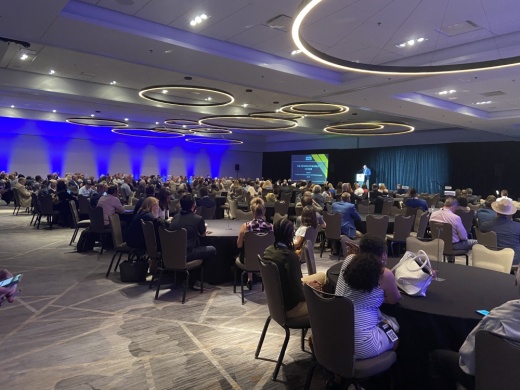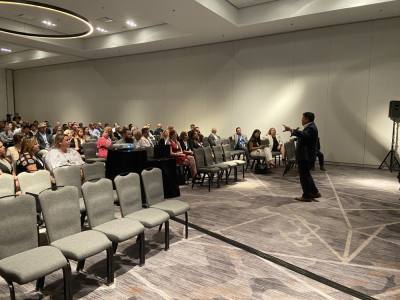The Austin Chamber of Commerce on Aug. 17 hosted an annual mobility summit at the Austin Marriott Downtown that brought together different local organizations that work to develop and improve transportation in Austin.
Topics discussed at the daylong event included planned improvements for the Austin-Bergstrom International Airport, downtown Austin traffic, and the redesign and reconstruction of I-35 throughout Central Texas.
ABIA improvements
With regard to the Austin-Bergstrom International Airport, ABIA Executive Director Jacqueline Yaft presented some plans at the Aug. 17 summit.
Yaft said because the airport will likely see 30 million passengers annually by May 2037, plans are underway for a three-phase improvement program that will expand the Barbara Jordan Terminal; develop Concourse B; and upgrade airfield and roadway infrastructure.
The improvements are slated to be completed by 2030, she said.
Some of the challenges identified in developing improvements for the future of aviation transportation in Austin included climate change, economy, passenger expectations, workforce planning, technological advancements and airline infrastructure, Yaft said.
Improving downtown Austin transportation
Dewitt Peart, president and CEO of the Downtown Austin Alliance, spoke about the need to improve transportation aspects of downtown Austin.
“So, when you look at downtown, the urban core is one-half of 1% of the city's land area," Peart said. "It generates a disproportionate amount of tax revenue, real estate tax, ad valorem and sales tax that gets spread out across the city, which is an important factor, and that's why it's so important to protect what goes on downtown.”
Jenell Moffett, associate vice president for strategic initiatives at the Downtown Austin Alliance, said the population of downtown Austin has been steadily increasing. Despite the addition of 619 new apartments in the downtown area in 2021, Moffett said housing inventory is being absorbed quickly.
According to Peart and Moffett, the downtown area has 47 new development projects underway that, when complete, will add 9.5 million square feet of office space, 6,000 new apartments, 1,600 new condos and 2,600 new hotel rooms. The new developments increase the need for the downtown area to be accessible through different transportation methods, they said.
Peart cited as an example the Cypress and Shoal Creek district in the heart of downtown.
“The west side of downtown, Cypress and Shoal [Creek], is developing into a complete neighborhood with an increased number of residential properties," Peart said. "There are several projects planned ... that will transform the area and extend downtown, making it more walkable, bikeable and connected to the trails, sidewalks and roadways.”
Overhauling I-35
During the Aug. 17 summit, Mike Trimble, director of the corridor program office for the city of Austin, spoke about plans to redesign I-35 through Austin.
“The current design is to restructure that highway to put all the main lanes below street level, and that's huge," Trimble said. "Remove the upper decks—remove all the elevated sections of I-35 through downtown—and basically put all of those main lanes below street level.”
Trimble also discussed what he described as the racial divide that construction of I-35 caused and how rebuilding the freeway can help bring communities together.
“It really did double down on the segregation that was already happening in the city through the early to mid-20th century,” Trimble said. “So we had communities of color that were displaced over to East Austin, east of East Avenue.”
Trimble said one way to diminish the racial divide involves installing caps, or land bridges, on top of the interstate throughout Austin. He explained a cap is a large deck over a highway that will accommodate new programming, such as structures or green space.
According to Trimble, the reconstruction of I-35 and the use of caps will help bring communities together, including ones that were affected by the construction of I-35.
“We have an opportunity, almost as a central lawn for Austin, to make all these connections and be kind of the hub and have all of these spokes and make all of these connections, including connections to some of the historical neighborhoods and those historical parks that are on the east side that even reach further out beyond where the cap locations are,” Trimble said.
Editor's note: This story was updated to correct the spelling of Mike Trimble's name.






